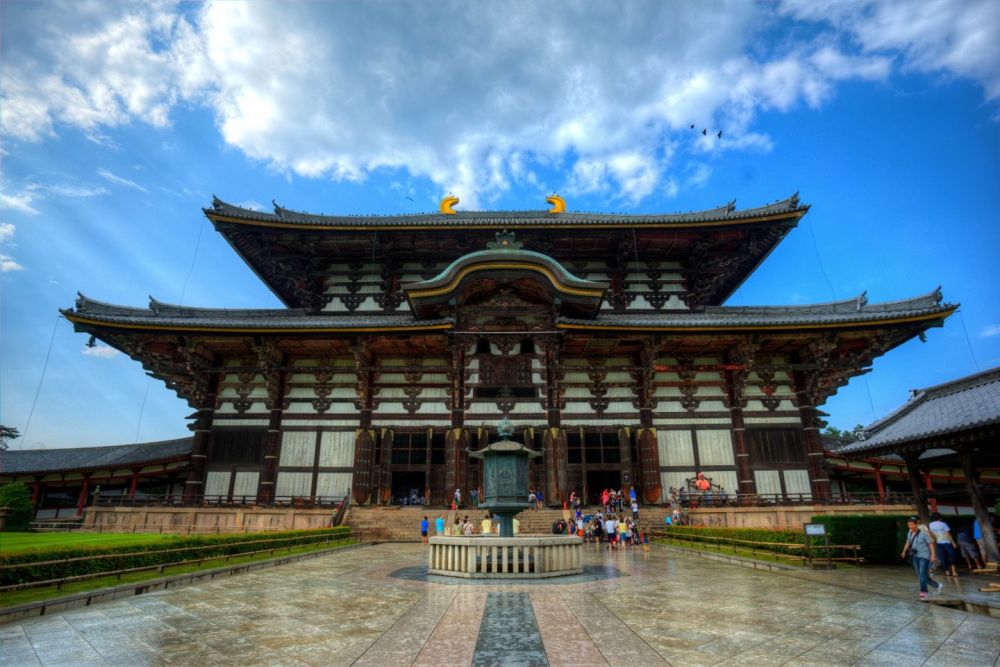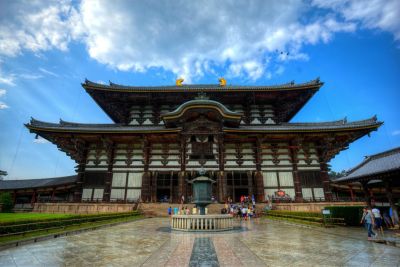

The Great Buddha Hall, also known as Daibutsuden, is the iconic centerpiece of Todaiji Temple and houses one of Japan's most famous and significant Buddha statues, the Daibutsu. This colossal bronze statue stands at over 15 meters tall and dates back to 752 AD, representing Vairocana Buddha. Visitors from around the world come to marvel at the sheer scale and craftsmanship of both the statue and the surrounding hall, which, by itself, is an architectural masterpiece. The hall's history, marked by destruction and reconstruction due to natural disasters, tells a tale of perseverance and cultural importance. A visit entails an awe-inspiring walk through the spacious interior, where you can also find models of the temple’s previous iterations and other smaller statues of Buddhist figures, offering an immersive experience into Buddhist art and history.
The Nigatsudo and Sangatsudo Halls are two important sub-complexes within the Todaiji Temple grounds. Nigatsudo, which translates to 'Hall of the Second Month,' is famous for its Omizutori ceremony held in March, illuminating the night with large torches and providing a spiritual spectacle for the attendees. Sangatsudo, also known as Hokkedo, houses a collection of significant Buddhist statues and is the second oldest building in Todaiji after the Great Buddha Hall. Visitors can enjoy a guided tour to learn about the history, religious significance, and the architectural details of both halls. The Nigatsudo platform also offers a breathtaking view over Nara Park, especially during sunset, making this tour a blend of cultural enlightenment and scenic beauty.
The Shuni-e ceremony (Omizutori) is a traditional Buddhist event held annually in March at Todaiji's Nigatsudo Hall. This spectacular two-week-long ritual involves several ascetic practices and rites, dating back over 1250 years. Visitors can witness monks performing the water-drawing ritual, Otaimatsu (torch-lit procession), and reciting sutras, amongst other rites aimed at repenting sins and purifying the temple ahead of spring. This night-time event is both a visual and cultural feast, as monks run along the balconies holding large, flaming torches, casting a warm glow and sparks over the crowd. For many, attending the Shuni-e ceremony is a once-in-a-lifetime opportunity to engage with Japan's ancient religious traditions and observe the devotion at the heart of Todaiji's monk community.
Combine a pleasant stroll through Nara Park with a tour of Todaiji Temple for an afternoon of wildlife and culture. Nara Park is renowned for its friendly free-roaming deer considered messengers of the gods in Shinto. After interacting with these gentle creatures and perhaps feeding them with special crackers sold in the park, visitors can proceed to Todaiji Temple. The walking tour typically includes the Great Buddha Hall and other smaller halls and museums within the complex. Guides often share insights into the history, architecture, and religious practices related to Todaiji, making this an enriching experience that beautifully melds nature with spirituality.
The Kaidan-in is a significant structure within the Todaiji complex, serving as the ordination platform for new monks, a practice established in the temple since 754 AD. Although the original building no longer exists, having been destroyed by warfare in the 16th century, the reconstructed platform allows visitors to contemplate the long-standing traditions of Japanese Buddhism. Kaidan-in serves as a tangible link to the past, with its tranquil surroundings offering a place for reflection amidst the vibrant cultural activities at Todaiji. Visiting the platform presents travelers with a deeper appreciation for the historical depth of the temple and a chance to explore lesser-known aspects of the cultural heritage preserved in Nara.
The Todaiji Museum of Treasure, boasting an impressive collection of religious art and artifacts, provides a comprehensive perspective on the temple's rich heritage. Exhibits showcase the temple's long history, including ceremonial utensils, intricate carvings, and ancient texts. The museum's rotating display means that each visit can offer a new glimpse into the vast collection that Todaiji has accumulated over the centuries. Art enthusiasts and history buffs alike can spend time admiring pieces that reflect the temple’s significant influence on Japanese culture. Additionally, some exhibits give detailed accounts of the temple's restoration projects, underlining the enduring efforts to preserve this UNESCO World Heritage site.
Todaiji's Bell Tower is home to a large bronze bell that dates back to the 8th century. It is rung several times a day in a ritualistic manner, signaling various times for prayer and meditation. Visitors have the opportunity to witness the ringing of the bell, which offers a resonant and deeply moving acoustic experience. While you cannot ring the bell yourself, being present for this time-honored tradition is a profound moment that connects you with Japan's spiritual customs. Some visitors choose to meditate or reflect on the serene sounds that radiate through the temple grounds, creating a peaceful atmosphere conducive to contemplation and relaxation.
While not routinely associated with Todaiji Temple specifically, participating in a traditional Japanese tea ceremony in Nara can provide an additional cultural layer to your visit. The tea ceremony, also called 'sado' or 'chado,' is an art form that embodies harmony, respect, purity, and tranquility. Several locations within Nara may offer this activity, where guests are invited to observe or partake in the ceremonial preparation and serving of matcha, powdered green tea. The ceremony is a meditative process that encourages mindfulness and appreciation for the meticulous art of tea. Part of the experience includes savoring Wagashi (traditional Japanese sweets) that complement the bitterness of the tea.
The immaculate and serene gardens surrounding Todaiji Temple are often overlooked in favor of the impressive Great Buddha Hall, but they offer a tranquil retreat for those seeking solace from the crowds. Visitors can leisurely walk among beautifully landscaped gardens featuring manicured trees, ponds, and seasonal flowers. The garden’s picturesque setting is perfect for a calming stroll and photography, providing a harmonious blend of natural and religious aesthetics. In particular, during cherry blossom season, the gardens become a splendid viewing spot, showcasing a dazzling array of blossoms against the ancient architectural backdrop.
Todaiji occasionally hosts workshops and cultural demonstrations, offering visitors a hands-on approach to traditional Japanese arts and crafts. These activities can range from calligraphy and origami workshops to incense ceremonies and Buddhist sutra copying, known as 'shakyo.' By participating, guests not only learn about the cultural significance of these art forms but also gain personal insight by creating their work. These workshops are held intermittently, and it’s best to check the Todaiji's official website or local tourist information for schedules and whether any additional fees or reservations are required.
